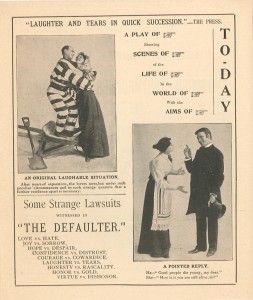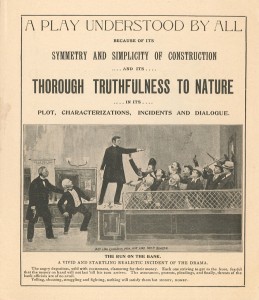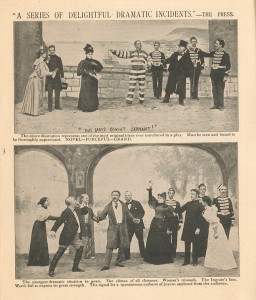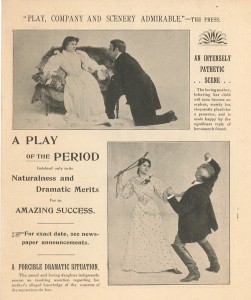A reference question sent our graduate fellow Gyorgy “George” Toth looking in our John Springer Printed Ephemera Collection, which has some amazing playbills, programs, and advertisements of popular theater from the turn of the 19th and 20th centuries. There he found an advertising booklet for the play “The Defaulter,” which has some arresting imagery, as you can see below.
The play is advertised as “A Play of Today – showing Scenes of Today – of the Life of Today – in the World of Today – with the Aims of Today,” and “a Play Understood by All because of its Thorough Truthfulness to Nature.” What was “the world of today”? And what real events was the play based on?
A quick search by our Instruction and Outreach Librarian Colleen Theisen revealed that the play was advertised (and likely performed) as early as January of 1896. If it was based on real events, this means that the crisis it refers to predates the Great Depression!
In fact, by 1897 the United States had been in an economic depression for years. Farmers had been losing their land, the unemployed had been traveling the country for work, some people had defaulted on their loans, while others had made a run on the banks for their money. Yet others organized and marched to Washington, D.C. to plead their case with the government. While the play’s humor made the audience laugh, the tears they shed likely came from the viewers’ empathy for those in dire straits, and their fear of their own ruin.
By the late 19th century, melodrama as a stage and literary genre had acquired a reputation for being a lowbrow cultural form consumed by the unsophisticated members of the lower classes. This may be the reason why a reviewer (or promoter?!) assured newspaper readers in 1896 that “It is a drama abounding in strong situations and thrilling climaxes, but there is nothing of a Melodramatic character about it.”
After the turn of the 19th and 20th centuries, the genre of melodrama migrated from novels and the stage to film and pulp literature. In the Victorian era and beyond, melodrama was a major cultural form in which people were both entertained and processed the complex experiences of romantic love, urban life, immigration, and industrial labor relations. Special Collections and University Archives has several major collections about the history of the U.S. stage and popular culture. Please look at their descriptions here: http://www.lib.uiowa.edu/spec-coll/resources/theatrearts.html
Do you know any plays or movies that are trying to give hope to Americans struggling with today’s global recession?




